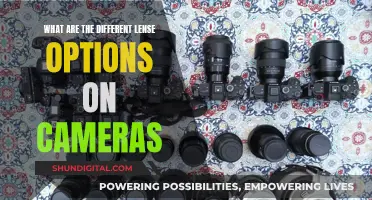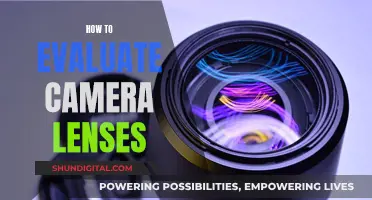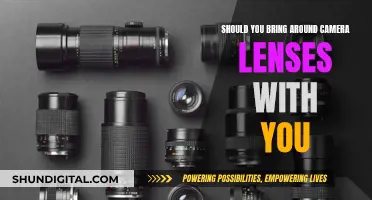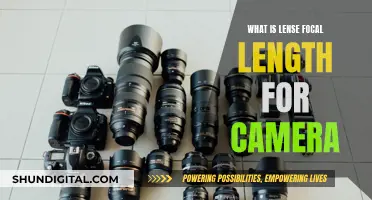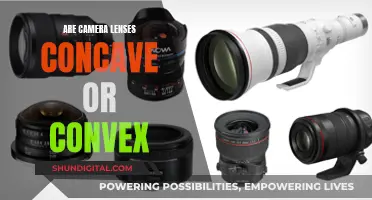
Camera lenses are measured in millimetres (mm) because it's a practical scale for measuring the distance between the plane of a camera lens and the subject of a shot. The focal length of a lens is the distance between the lens's optical centre and the camera's image sensor (or film plane) when focused at infinity. Focal length is usually displayed on the lens barrel, along with the size of the adaptor ring. This measurement is not of the actual physical length of the lens but rather the magnification properties of the lens.
| Characteristics | Values |
|---|---|
| Focal length | Measured in mm, this is the distance between the lens' optical centre and the camera's image sensor (or film plane) when focused at infinity. |
| Focal length calculation | Calculated by measuring the distance in mm between the convergence point and the imaging sensor. |
| Focal length and magnification | The longer the focal length, the narrower the angle of view and the higher the magnification. |
| Focal length and angle of view | The shorter the focal length, the wider the angle of view and the lower the magnification. |
| Prime vs zoom lenses | Prime lenses have a fixed focal length, while zoom lenses have variable focal lengths. |
| Lens diameter | Determines the size of the threaded filter. |
| Aperture | The aperture determines how much light the lens transmits to the image sensor. A lower maximum aperture value indicates a higher quality lens in terms of brightness. |
| F-stop value | The widest aperture of the lens or how fast it can go. |
| Minimum focusing distance | Measured in meters and feet, this tells the photographer how close they can get to their subject before the lens can no longer focus clearly. |

Focal length
There are two types of lenses: prime and zoom. Prime lenses have a fixed focal length, whereas zoom lenses have variable focal lengths. Zoom lenses are more versatile and can be used for photographing a variety of subjects, such as landscapes and portraits. They also reduce the number of times you need to change the lens, saving time and limiting the possibility of dust entering the camera. On the other hand, prime lenses tend to be more compact and lightweight than zoom lenses, and they also tend to have a larger maximum aperture, making them ideal for shooting in low-light conditions.
Common focal lengths include 24mm, 50mm, and 85mm. It is important not to mistake the diameter of your lens for the focal length, as they are two different measurements. The diameter of the lens determines the size of the threaded filter, while the focal length is the distance from the sensor to the point of convergence, or where all light that passes through the lens converges and then passes to the sensor together.
Samsung Galaxy S10: The Power of Triple Camera Lens
You may want to see also

Lens diameter
When shopping for filters, lens caps, or hoods, you need to know the diameter of your lens. The lens diameter is the physical measurement of the diameter of the front-most part of the lens. It is different from the focal length and aperture.
The lens diameter is often threaded to allow filters and lens hoods to screw in. The diameter is usually marked on the lens using the symbol "ø" followed by a number (e.g. ø52 for 52mm). If it's not marked, you can measure the widest part of the lens or refer to the lens specifications. Common DSLR lens diameters include sizes like 52mm, 58mm, 72mm, and 77mm.
It's important to note that there is no standard lens diameter size. However, some common sizes for the diameter of DSLR lenses are 43mm, 49mm, 52mm, 44mm, 58mm, 62mm, 68mm, 72mm, and 77mm. The right size filter for your lens is crucial—a 72mm filter won't fit a lens with a 77mm diameter.
While the lens diameter doesn't directly determine image quality, it is related to the focal length and maximum f-number. A larger lens diameter usually indicates a smaller maximum f-number, which means the lens will let in more light and potentially produce better-quality images.
Stealth Trail Cameras: Do They Have Lenses?
You may want to see also

F-stop value
F-stop, also referred to as "F-number", is a crucial concept in photography, denoting aperture measurements on your camera. The aperture, or the "hole" in the middle of the lens, is made up of rotating blades that open to let in light when you press the shutter release.
The f-stop value, expressed as a fraction, with "f" as the numerator and the f-stop number as the denominator, determines how much light enters the camera lens. The aperture size is inversely proportional to its corresponding f-number: a smaller f-number indicates a larger aperture, while a larger f-number means a smaller aperture. For example, f/4 is a larger aperture than f/16.
The f-stop value is calculated by dividing the lens's focal length by the f-number. For instance, a 200mm lens with an f/4 aperture has a diameter of 50mm (one-quarter of 200mm).
The f-stop value impacts the exposure of your image. In Manual mode, changing the aperture without adjusting the shutter speed will make your image darker or lighter. However, in Aperture Priority mode, the camera automatically adjusts the shutter speed to maintain a consistent exposure as you change the aperture.
Additionally, the f-stop value affects the depth of field, which refers to the range within a scene that appears in focus. Photographers often use medium to small apertures (larger f-number) to achieve greater sharpness throughout the image.
The type of lens you should use depends on your photography needs. For astrophotography or low-light settings, a wider aperture (smaller f-number) like f/2.8 or wider is recommended. On the other hand, landscape photographers shooting in broad daylight may opt for smaller apertures (larger f-number) like f/8 or higher.
Projector Lenses: Can They Double as Cameras?
You may want to see also

Minimum focusing distance
The minimum focusing distance is often listed in the lens specifications and is usually measured in centimetres or inches. It can vary significantly between different lenses, even those with the same focal length. For example, a macro lens designed for extreme close-up photography may have a minimum focusing distance of just a few centimetres, while a telephoto lens might have a minimum focusing distance of several metres.
Understanding the minimum focusing distance of your lens is crucial for various types of photography. For example, in macro photography, where extreme close-ups of small subjects are captured, a short minimum focusing distance is essential. This allows photographers to get extremely close to their subjects, such as insects, flowers, or small products, and capture fine details that would be impossible with a longer minimum focusing distance.
Additionally, the minimum focusing distance impacts the maximum magnification achievable by a lens. Lenses with shorter minimum focusing distances typically offer higher magnification capabilities, making them ideal for photographing small objects at close range. This is particularly important in fields such as product photography, where precise control over the subject's size in the frame is required.
When choosing a lens, it is essential to consider the minimum focusing distance in conjunction with other specifications, such as focal length and aperture. By understanding how these factors interact, photographers can make informed decisions about the best lens for their specific needs, ensuring they can capture their desired shots with sharp focus and the desired composition.
Understanding Camera Lenses: Converging or Diverging?
You may want to see also

Image stabilisation
Lens-Based Image Stabilisation
Lens-based image stabilisation uses a floating lens element, which is electronically controlled and shifted opposite to any camera shake recorded by the camera. This technology is implemented in the lens itself, and it stabilises the recorded image by varying the optical path to the sensor. Different manufacturers have different names for this technology, including:
- Vibration Reduction (VR) – Nikon
- Image Stabilizer (IS) – Canon
- Anti-Shake (AS) – Minolta and Konica Minolta
- Optical SteadyShot (OSS) – Sony
- Optical Image Stabilization (OIS) – Fujifilm
- MegaOIS, PowerOIS – Panasonic and Leica
- Optical Stabilization (OS) – Sigma
- Vibration Compensation (VC) – Tamron
- Shake Reduction (SR) – Pentax
Lens-based stabilisation has a number of advantages. Firstly, it provides a smoother view through the viewfinder, which is especially useful for DSLRs that do not have any stabilisation built-in. Secondly, it is often the only option available for longer lenses. However, one downside is that it adds to the cost of the lens.
In-Camera Image Stabilisation
In-camera image stabilisation, also known as in-body image stabilisation (IBIS), physically shifts the image sensor to compensate for camera shake. IBIS is available on cameras from manufacturers such as Panasonic, Sony, and Pentax. One advantage of IBIS is that it works with any lens, including older manual lenses. This means that shorter focal length-lens designs can be simpler and potentially lighter, as the stabilisation gadgetry does not need to be incorporated into the lens. Additionally, IBIS is usually less expensive than lens-based stabilisation, as you don't need to buy multiple IS-enabled optics.
However, one disadvantage of IBIS is that it is less effective at smoothing bumps when shooting with longer focal length optics compared to lens-based stabilisation. Another drawback is that the image projected to the viewfinder is not stabilised, which can make it more challenging to compose your shot accurately.
Compatibility of Pentax Lenses with Fujica Cameras
You may want to see also
Frequently asked questions
Focal length is the distance in millimetres between the optical centre of the lens and the camera's image sensor. It is usually displayed on the lens barrel.
The focal length of a lens determines the angle of view and the magnification. A shorter focal length provides a wider field of view but less magnification, while a longer focal length provides a narrower field of view but greater magnification.
Prime lenses have a fixed focal length, meaning you have to physically move closer or further away from your subject to change how close they appear in your shot. Zoom lenses have a variable focal length, allowing you to change how close your subject appears without physically moving.
The size of a camera lens is determined by its diameter, which can be measured with a ruler or tape. However, this can often be found written on the lens itself.
The f-stop value is the widest aperture of the lens, or how fast it can go. The ratio number on the front end of the lens barrel (e.g. 1:2.8) is the maximum aperture of the lens.


